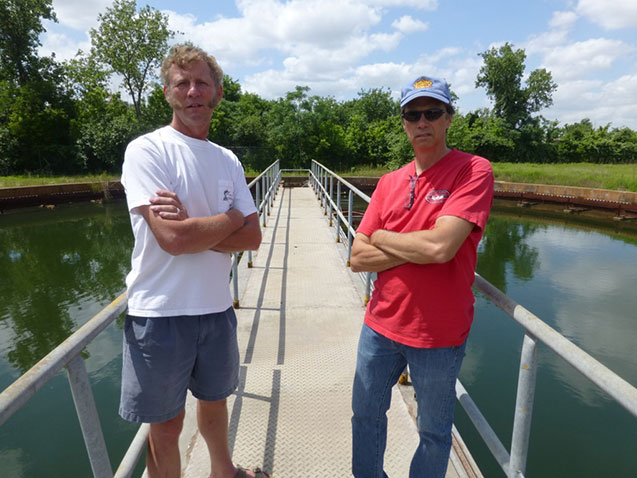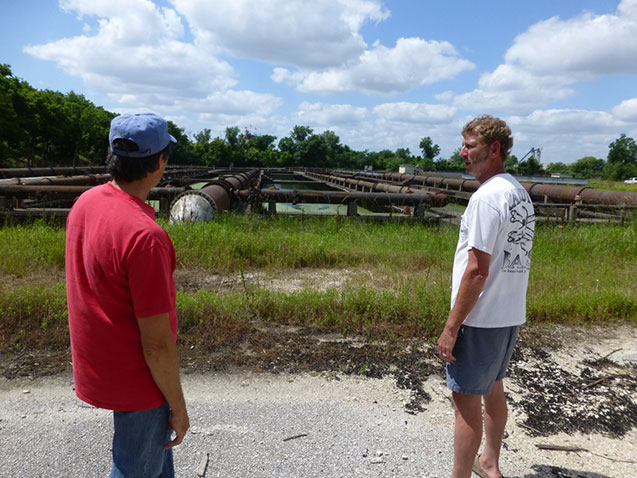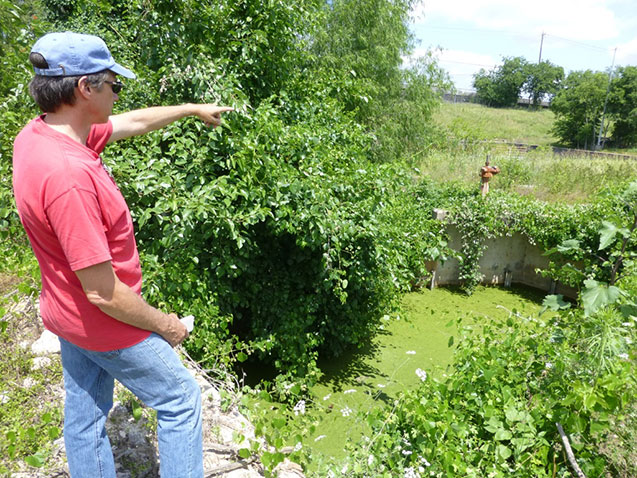
The Future of Food?
Dahr Jamail
Imagine a fish farm and vegetable garden that produces 500,000 pounds of fresh fish and 150,000 heads of lettuce annually.
Now imagine that the farm uses aquaponics, aquaculture and greenhouses, and is actually a reclaimed, bio-remediated wastewater treatment plant.
Lastly, imagine that, despite being located less than four miles from the downtown area of a city of more than six million people, it is completely self-sustaining and leaves no carbon footprint.
This lofty ideal is not a dream. It is in the process of becoming a reality.
The farm is the brainchild of artist Jack Massing and restaurateur Rob Cromie, and the city is Houston, Texas.
 Rob Cromie (L) and Jack Massing (R) are working to transform an abandoned water treatment plant into a fish farm and vegetable garden. (Photo: Dahr Jamail)
Rob Cromie (L) and Jack Massing (R) are working to transform an abandoned water treatment plant into a fish farm and vegetable garden. (Photo: Dahr Jamail)
"Food is our second largest trade deficit behind oil, and half of all our fish are imported," 55-year-old Cromie told Truthout, while standing in front of long open pools of water that he aims to fill with fish. "So we'd better be thinking of what we can do about that."
Cromie watched the prices he was paying for the seafood he uses in his four Houston restaurants double overnight in the immediate wake of the 2010 BP oil disaster in the Gulf of Mexico, and that got him thinking.
"I'm looking at why my food was costing so much, so I started researching fish and shrimp farming," he said.
Massing is one of two men known domestically and internationally as the famous artist team The Art Guys, whose work ArtNews has described as straddling "the boundaries between art and life, esthetics and commercialism, the rational and the absurd."
His community-based art projects have included using economic stimulus money to bring solar-powered streetlights, art-filled bus stops and infrastructure for farmers markets into poverty-stricken neighborhoods in Houston. Other projects have been direct responses to anthropogenic climate disruption (ACD).
Massing sees the farm as a synthesis of community building and land reclamation, and a way to feed people as economics and ACD make doing so increasingly challenging.
"We are planning on an education center, having local communities involved, and tying this into the city by using the bayou and incoming bike paths," he said of the site, which is located right on the banks of Houston's Buffalo Bayou.
Both Massing and Cromie are talking to scientists, filing for permits and securing necessary funding to have the farm operational within six months.
The Need
Both men are acutely aware of the critical necessity of their project and others like it.
Global agricultural projection needs to increase by 70 percent, at a minimum, by 2050 in order to keep apace with a projected 40 percent increase in population by that time.
According to UN statistics, 2.6 billion people depend directly on agriculture for their survival, and already 52 percent of the land used for agriculture is moderately or severely affected by soil degradation, and arable land loss is occurring at 30-35 times the historical rate thanks in large part to ACD.
William Ryerson, founder and president of the Population Media Center and president of the Population Institute, is also very concerned about industrial agriculture fertilizers' impact on soil. He has questioned how, in the long run, this will impact agriculture. "The world's agricultural systems rely substantially on increasing use of fertilizers," Ryerson told Truthout in 2011. "But now, the world's farmers are witnessing signs of a declining response curve, where the use of additional fertilizer yields little additional food product. At the same time, fertilizers and intensive cropping lower the quality of soil. These factors will more and more limit the possibilities of raising food production substantially and will, at a minimum, boost relative food prices and resulting hunger for many."
Ryerson warns of these trends causing massive food shortages in the future.
"Because of industrialization leading to loss of agricultural land, population growth, and the demand for more meat instead of grain as incomes rise, China is projected to need to import 240 million tons of food annually by the year 2030," he said. Projections also show that India, currently a food exporter, will need to import 30 million tons a year by also 2030. "Yet total world agricultural trade is currently just 200 million tons of grain or grain equivalent, and that amount is decreasing as the exporting countries consume more and more of their own food products," said Ryerson. "Accordingly, the increasing demand for food imports by growing economies like China's will almost certainly drive up the price of food over the next 30 years, virtually ensuring that more people elsewhere will suffer from starvation."
"We're currently producing food using 98 percent of all the arable land available, and we're already under-producing for our current population levels," Cromie explained. "By 2050 we are projected to have at least nine billion people on the planet. So this kind of process we're looking at here is the most likely solution that will help us get there because of the minimal water usage, it is small scale."
He added that another factor is the feed conversion rate for protein provided by fish. Feed conversion rate is a measure of an animal's efficiency in converting feed mass into increases in the desired output.
"For beef it is 13 to one, as compared to tilapia, one of the fish we're going to raise, which has a feed conversion rate of 1.5 to one," he said. "No other protein beats fish in the conversion rate."
Chandler Goule, vice president of government relations for the National Farmers Union in the US, told Truthout in 2011 of his concerns around ACD's increasing impacts on humans' ability to feed ourselves. "As we continue to see increasing weather disasters in the US and around the world, we will see increasing food costs, hungry people, and this will cause the consumer to spend more of their income on food," Goule told Truthout.
In the three years since Goule spoke those words, things have become far worse, and the need for a solution like Cromie and Massing's is even greater.
The Plan
The Lockwood Wastewater Treatment Facility in Houston's Fifth Ward was the largest facility of its kind when it was built.
 The site contains four round water tanks and six "raceway" tanks, and is located four miles from downtown Houston. (Photo: Jack Massing)
The site contains four round water tanks and six "raceway" tanks, and is located four miles from downtown Houston. (Photo: Jack Massing)
Twenty years ago it closed down and was replaced by a far larger plant, a move that set the stage for Cromie and Massing's idea.
Both of them have been studying aquaculture, composting and gardening, and are working with scientists from Texas A&M University, who are counseling them on how to prepare the water tanks to raise fish. Other experts include an advisor from the Texas Parks and Wildlife Department and a scientist from Rice University, who is an energy expert.
"The tanks are isolated, so each one [is] its own system, meaning we can raise both fresh and saltwater fish," Cromie said.
Their plan aims to dispel common concerns about farmed fish being less healthy due to the enclosed environment.
"We'll use basic aquaponics, so the fish eat their feed, their waste creates nitrites which are consumed by bacteria and then turned into nitrates that the plants use," Cromie explained.
They aim to raise redfish, striped bass, ling and tilapia, for starters, and plans are in the works to secure funding for a 20,000 square foot state of the art greenhouse.
 The men are in the process of obtaining the necessary insurance and permits to begin farming within six months. (Photo: Dahr Jamail)
The men are in the process of obtaining the necessary insurance and permits to begin farming within six months. (Photo: Dahr Jamail)
The Buffalo Bayou Partnership that owns the property has already given them permission to begin fish farming, and they are working with them to secure a long-term lease.
"This is in the City of Houston's best interest, because there is virtually no carbon footprint," Cromie added.
The property has 10 massive water tanks (four round and six "raceways") that will each be filled with enough sediment so the bottom is consistently seven feet, as some of them are currently as deep as 20 feet.
They will begin by having one of the tanks prepared and filled with freshwater fish to begin the plan roughly six months from now.
Massing explained that the plans will be designed to bring in community members and their children to the education center "where we will show them what this place used to look like, and how it operates now."
Three companies have already been created for the project. One of them will focus on growing the fish, another that sells the fish, and a third, named Local Waters, that will give food to local charities.
Massing plans to have the local community heavily involved in a composting project at the site, and said that once the site is fully operational, it will have at least two full-time employees and eight working part time.
"All of this will be done in a self-sustaining way, so that we are not dependent on grants or have to worry about having someone tell us how to do things," Massing said.
 Massing is aiming to utilize every part of the land for gardening, a community-composting project, and an education center. (Photo: Dahr Jamail)
Massing is aiming to utilize every part of the land for gardening, a community-composting project, and an education center. (Photo: Dahr Jamail)
All the fish will go to local markets to be sold, where the demand for greater numbers of less expensive fish is always increasing.
A silver lining amidst the darkening clouds of ACD and ongoing global economic crisis, Cromie and Massing hope their project might inspire others to spread throughout the country.
"Given what is happening on the planet," Massing said, while speaking about what needs to be done to keep his spirits up, "This is something we can do."
The project raises important questions as we look towards the future. In order to feed a growing population, funding on a large scale for reclamation projects such as this has to become feasible. Would that funding come through philanthropic billionaires or the government?
Widespread replication of Massing and Cromie's model would likely take a deep commitment on the part of either powerful people, or a collective movement by large numbers of motivated citizens.
The question is, then, will widespread reclamation of available urban properties to be used as farms such as this begin while there is still time to do so?
This article is a Truthout original.
Dahr Jamail
Dahr Jamail, a Truthout staff reporter, is the author of The Will to Resist: Soldiers Who Refuse to Fight in Iraq and Afghanistan, (Haymarket Books, 2009), and Beyond the Green Zone: Dispatches From an Unembedded Journalist in Occupied Iraq, (Haymarket Books, 2007). Jamail reported from Iraq for more than a year, as well as from Lebanon, Syria, Jordan and Turkey over the last ten years, and has won the Martha Gellhorn Award for Investigative Journalism, among other awards.
http://truth-out.org/opinion/item/23909-the-future-of-food?tmpl=component&print=1
